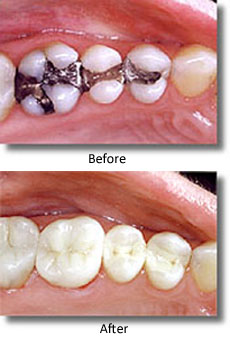I have a young enthusiastic dentist whose treatment is really affordable. I’ve been a patient for almost 3 years and have been pleased with her gentle care and treatment. In mid-September, I had 3 small fillings filled with flowable resin-based composites. These fillings have been a problem ever since I received them. Whenever I chew hard crunchy food, like dark chocolate covered toffee, which I love, I get sharp pains. It doesn’t last long, but toffee takes some time to chew, so the pain repeats itself. It happens with other hard crunchy food, too.
Of course, I have mentioned the issue to my dentist. In late October, at no cost to me, she replaced the fillings with the same composites, but I still have pain that is pretty much at the same level as the first fillings. This pain does not occur when I clench my teeth together – only with hard crunchy food.
I’ve read a few dental articles online about this issue with small fillings and learned that before placing the flowable composite, self-etching primers or a glass ionomer base might help. Does my dentist not know this because she is young, or might she be skipping the step to make this dental procedure affordable? Does using this base sound reasonable, and is it a no-no for me to ask my dentist about her technique? Thanks. Sunni
Sunni – The sensitivity that commonly occurs with flowable resin-based composites in small fillings, as opposed to larger ones, seems to be related to bonding the filling to the dentin of the tooth.
We won’t suggest that your dentist isn’t using the base just to make dental care affordable. It is possible that she is unaware of the benefits of using self-etching primers or a glass ionomer base. Or, she might typically have success without using a base under flowable fillings.
What’s Next?
Below are two options to consider.

- Schedule an appointment with your dentist to have the fillings replaced again. Before she starts the work, insist on a glass ionomer base to protect the dentin. The composite will be bonded to the base, not the dentin, and you should have relief when you chew hard crunchy foods. If your dentist refuses to apply the base, you can refuse further treatment.
- Find an experienced cosmetic dentist to replace the fillings. He or she will know how to prepare your tooth to ensure flowable composite doesn’t cause any discomfort when you chew. And keep in mind that regardless of which type of composite a skilled cosmetic dentist uses, the results will function well and look natural. No critical steps will be skipped to keep costs down.
This post is sponsored by Plano, TX female cosmetic dentist Dr. Miranda Lacy. Dr. Lacy doesn’t take shortcuts to make dental care affordable. She provides high-quality care and offers payment options to help you get the care you need.
